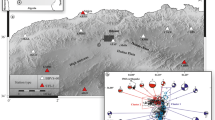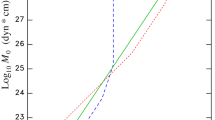Abstract
The systematic deviation of the magnitude of a single earthquake from the linear orthogonal regression between local magnitudeM L and coda duration magnitudeM d, calculated for the whole region, is used as a measure of the frequency content of the seismic sources in the Italian region. Predominantly high frequency events are found in the two areas of Quaternary tectonic shortening in North-Central Italy and in the Calabrian Arc. This result, confirmed by two independent statistical tests, is in agreement with the global pattern obtained from the study of the regression between body-wave magnitude,m b, and surface-wave magnitudeM s : systematic shift to high frequencies in the energy release of seismic sources located in subduction zones and to low frequencies in zones of spreading.
Riassunto
Lo scostamento sistematico della magnitudo di un singolo terremoto dalla regressione lineare ortogonale tra la magnitudo localeM L e la magnitudo da durataM d, calcolata per tutta la regione, viene usato come misura del contenuto spettrale delle sorgenti sismiche nella regione italiana. Gli eventi con radiazione predominante ad alta frequenza tendono a raggrupparsi in corrispondenza delle due aree di accorciamento tettonico Quaternario nell’Italia Centro-Nord e nell’Arco Calabro. Tale risultato, confermato da due tests statisticamente indipendenti, è in accordo con l’andamento globale, definito dall’analisi della regressione lineare tra magnitudo da onde di corpo,m b , e magnitudo da onde superficiali, Ms, che indica uno spostamento sistematico verso le alte frequenze nella radiazione delle sorgenti sismiche localizzate in zone di subduzione e verso le basse frequenze per quelle situate in zone di apertura.
Similar content being viewed by others
References
Adams R. D., 1982.Local earthquake quantification. Tectonophysics, 84: 33–39.
Aia K., Chouet B., 1975.Origin of coda waves: Source, attenuation and scattering effects. J. Geophys. Res., 80: 3322–3342.
Alessandrini B.,Amato A.,Cimini C. B., 1990. Distribuzione dei residui telesismici nella regione italiana dall’analisi di forme d’onda digitali. Submitted to Atti 8° Convegno GNGTS, CNR, Rome.
Basham P. W., 1969.Canadian magnitudes of earthquakes and nuclear explosions in south-western North America. Geophys. J. R. astr. Soc, 17: 1–13.
Bath M., 1981.Eartquake magnitudes - recent research and current trends. Earth-Science Reviews, 17: 315–398.
Benioff H., Press F., 1958.Progress report on long pcriod seismograpbs Geophys. J. R. astr. Soc, 1: 208–215.
Beroza G. C., Jordan T. H., 1990.Searching for slow and silent earthquakes using free oscillations. J. Geophys. Res., 95: 2485–2510.
Bisztricsany E., 1958.A new method for the determination of the magnitude of earthquakes. Geofiz. Kozl., 1: 69-96 (in hungarian).
Calcagnile G., Panza G. F., 1981.The main characteristics of the lithosphere-asthe nosphere system in Italy and surrounding regions. Pure Appl. Geophys., 119: 865–879.
Caputo M., Panza G. F., Postpischl D., 1970.Deep structure of the Mediterranean basin. J. Geophys. Res., 75: 4919–4923.
Caputo M., Panza G. F., Postpischl D., 1972.New evidences about the deep structure of the Lipari Arc. Tectonophysics, 15: 219–231.
Chung D. H., Bernreuter D. L., 1981.Regional relationships among earthquakes magnitude scales. Review Geophys. Space Phys., 19: 649–663.
Della Vedova B.,Marson I.,Panza G. F.,Suhadolc P., 1990.Upper mantle properties of the Tuscan-Tyrrhenian area: a frame for its recent tectonic evolution. Tectonophysics, in press.
Dziewonski A. M., Gilbert F., 1974.Temporal variation of the seismic moment tensor and evidence of precursive compression for two deep earthquakes. Nature, 247: 185–188.
Dziewonski A. M., Woodhouse J. H., 1983.Studies of the seismic source using normal-mode theor;. In:Earthquakes: Observation, Theory and Interpretation. North-Holland, New York: 45–137.
Evernden J. F., Filson J., 1971.Regional dependence of surface wave vs. body-wave magnitudes. J. Geophys. Res., 76: 3303–3308.
Gusev A. A., 1988.Two dilatancy-based models to explain coda-wave precursors and P/S spectral ratio. Tectonophysics, 152: 227–237.
Herrman R. B., 1980.Q estimates using the coda of local earthquakes. Bull. Seism. Soc. Am., 70: 447–468.
Jordan T. H., Sheehan A. F., Rdedesel M. A., 1988.Detecting slow precursors to fast seismic ruptures. EOS Trans. AGU. 69: 1304.
Kanamori H., 1972.Mechanism of tsunami earthquakes. Phys. Earth Planet. Int., 6: 346–358.
Kanamori H., Stewart G. S., 1976.Mode of strain release along the Gibbs Fracture-Zone, Mid-Atlantic Ridge. Phys. Earth Planet. Inter., 11: 312–332.
Kanamori H., Stewart G. S., 1979.A slow earthquake. Phys. Earth Planet. Inter., 18: 165–175.
Keilis-Borok V. I., 1960.The difference of spectra of surface waves of earthquakes and underground explosions. Proc. Earth Physics Inst., 15 (in russian). ING,Setsmological Reports 1983-1989. ING, Rome.
Lee W. H. K.,Bennett R. E.,Meagher K. L., 1972.A method of estimating magnitude of local earthquakes from signal duration. Geol. Surv. Open File Rep. U.S., 72-223, 28 pp.
Linde A. T., Suyehiro K., Miura S., Sacks I. S., Takagi A., 1988.Episodic aseismic earthquake precursors. Nature, 334: 513–515.
Malamud A. S., 1964.On the possibility of earthquake classification via duration of seismogram. Izvestia Akad. Nauk. USSR, ser. geophys, 5: 728-732 (in russian).’
Okal E. A., Stewart L. M., 1982.Slow earthquakes along oceanic fracture zones: Evidence for asthenospheric flow from hotspots? Earth Planet. Sci. Lett., 57: 75–87.
Panza G. F., Duda S. J., Cernobori L., Herak M., 1989.Gutenberg’s surface-wave magnitude calibration function: Theoretical basis from synthetic seismograms. Tectonophysics, 166: 35–43.
Patacca E., Scandone P., 1989.Post-Tortonian mountain building in the Apennines. The role of the passive sinking of a relic lithospheric slab. In: A. Boriani, M. Bonafede, G. B. Piccardo, G. B. Vai (eds.),The lithosphère in Italy. Advances in Earth saence research. Acc. Naz. Lincei, Atti Conv. Lincei, 80: 157–176.
Prozorov A. G., Hudson J. A., 1974.A study of the magnitude difference M s - m b for earthquakes. Geophys. J. R. astr. Soc., 39: 551–554.
Prozorov A. G., Hudson J. A., Shimshoni M., 1983.The behaviour of earthquake magnitudes in space and time. Geophys. J. R. astr. Soc., 73: 1–16.
Prozorov A. G., Sabina F. J., 1984.Study of properties of seismicity of the Mexico region. Geophys. J. R. astr. Soc., 76: 317–336.
Rautian T. G., Khalturin V. I., 1978.The use of the coda for determination of earthquake source spectrum. Bull. Seismol. Soc. Am., 68: 923–948.
Richter C. F., 1935.An instrumental earthquake magnitude scale. Bull. Seismol. Soc. Am., 25: 1–32.
Richter C. F., 1958.Elementary seismology. W. H. Freeman and Co., San Francisco, 768 pp.
Royden L., 1988.Flexural behaviour of the continental lithosphere in Italy: constraints imposed by gravity and deflection data. J. Geophys. Res., 93: 7747–7766.
Sato H., 1987.A precursorlike change in coda excitation before the Western Nagano earthquake (M s = 6.8)of 19S4 in Central Japan. J. Geophys. Res., 92: 1356–1360.
Scholz C. H., Wyss M., Smith S. W., 1969.Seismic and aseismic slip on the San Andreas fault. J. Geophys. Res., 74: 2049–2069.
Snieder R., 1988.Large-scale waveform inversions of surface waves for lateral heterogeneity 2. Application to surface waves in Europe and the Mediterranean. J. Geophys. Res., 93: 12067–12080.
Solov’ev S. L., 1965.Seismicity of Sakhalin. Bull. Earthquake Res. Inst. Tokyo Univ., 43: 95–102.
Stewart L. M., Okal E. A., 1983.Seismicity and aseismic slip along the Eltanin fracture zone. J. Geuphys. Res., 88: 10495–10507.
Suhadolc P., 1978.Total durations and local magnitudes for small shocks in Friuli, Italy. Boll. Geofis. Teor. Appl. 79: 303–312.
Suhadolc P., Panza G. F., 1988.The european-african collision and its effects on the lithosphere-asthenosphere system. Tectonophysics, 146: 59–66.
Author information
Authors and Affiliations
Additional information
Nella seduta del 12 gennaio 1991.
Rights and permissions
About this article
Cite this article
Panza, G.F., Prozorov, A. High frequency seismic sources characterize the areas of tectonic shortening in the Italian region. Rend. Fis. Acc. Lincei 2, 107–116 (1991). https://doi.org/10.1007/BF03001415
Issue Date:
DOI: https://doi.org/10.1007/BF03001415




